NavSource Online: Submarine Photo Archive
S-48 (SS-159)
Awards, Citations and Campaign Ribbons
Precedence of awards is from left to right
American Defense Service Medal - American Campaign Medal - World War II Victory Medal
Please report any broken links or trouble you might come across to the Webmaster.
Please take a moment to let us know so that we can correct any problems and make your visit as enjoyable and as informative as possible.
| Click On Image For Full Size | Size | Image Description | Source | |
|---|---|---|---|---|
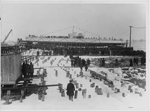 0815913b |
1.18k | Broadside view of the S-48 (SS-159) before her launching at Lake Torpedo Boat Co., Bridgeport, CT., 26 February 1921. | USN photo NH 108453 courtesy of Naval History and Heritage Command. | |
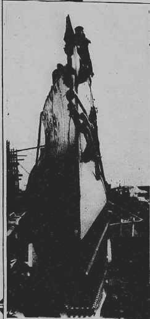 |
738k | ON THE WAYS. What the latest in our navy's submarines looks like bow on, just before it takes the water for the first time. An interesting view of the S-48 (SS-159) on the ways at Bridgeport just as she was about to be christened with a bottle of real champagne by the Indian Princess Tocoomas, who in private life is Mrs. James O.Germaine, of Norwich, Conn. | Photo by Underwood & Underwood. Image and text provided by Library of Congress, Washington, DC. Photo from New-York Tribune. (New York [N.Y.]) 1866-1924, 06 March 1921, Image 55, via chroniclingamerica.loc.gov. |
|
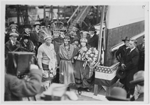 0815913 |
654k | Mrs. James O. Germaine, the S-48's (SS-159) sponsor, is the belle by the bottom of the bunting of the boat's bow before breaking the bottle of booze before her brow at Lake Torpedo Boat Co., Bridgeport, CT., 26 February 1921. | USN photo courtesy of facebook.com/The Mohegan Tribe. Insert PDF & image and text provided by University of North Carolina at Chapel Hill Library, Chapel Hill, NC. Photo from The Review.(High Point, N.C.) 1908-19??, 31 March 1921, Image 2, via chroniclingamerica.loc.gov. |
|
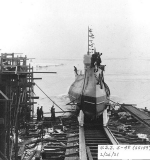 |
72k | S-48 (SS-159), at Lake Torpedo Boat Co., Bridgeport, CT., 26 February 1921. | USN photo courtesy of Ric Hedman / rddesign@rddesigns.com. | |
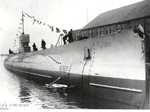 |
53k | Still signals sway from the sub as she is safely secured after a successful slide into the sea on 26 February 1921. | USN photo courtesy of Scott Koen & ussnewyork.com. | |
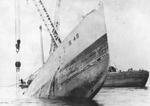 |
138k | Builder's trials were conducted on S-48 (SS-159) on the 7th of December 1921. During a dive off Penfield Reef, a manhole plate in one of the aft ballast tanks was left unsecured, and S-48 sank in 60 feet of water. The crew, contractor's personnel, and naval observers brought the bow to the surface and escaped through a torpedo tube to a tug which took them to New York. On 20 December, the submarine was raised and taken back to the builder's yard where repairs were begun. The work was completed ten months later; and, on 14 October 1922, S-48 was accepted by the Navy. | Text from DANFS. USN photo courtesy of Scott Koen & ussnewyork.com. |
|
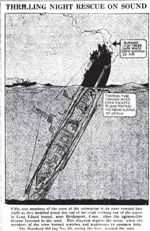 |
944k | THRILLING NIGHT RESCUE ON SOUND Fifty one members of the crew of the submarine S-48 (SS-159) were rescued last night as they huddled about the end of the craft sticking out of the water in Long Island Sound, near Bridgeport Conn., after the submersible became fastened in the mud. This diagram depicts the scene, when the members of the crew burned matches and mattresses to summon help. The Standard Oil tug No. 28, seeing the flare, rescued the men. |
Image and text provided by Penn State University Libraries; University Park, PA. Photo courtesy of Evening Public Ledger. (Philadelphia [Pa.]) 1914-1942, 08 December 1921, Night Extra, Image 1 via chroniclingamerica.loc.gov. |
|
 0815932 |
NR | S-48 (SS-159) SUNK THIS MORNING Entire Crew of Wrecked Submarine Believed To Be Safe Submarine Was Making Nose Dive When Accident Occurred in 70 Feet of Water. | Image and text provided by Connecticut State Library, Hartford, CT. Photo from The Bridgeport Times and Evening Farmer. (Bridgeport, Conn.) 1918-1924, 08 December 1921, Image 1, via chroniclingamerica.loc.gov. |
|
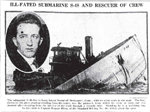 |
840k | ILL FATED SUBMARINE S-48 (SS-159) & RESCUER OF CREW. | Image provided by: Penn State University Libraries; University Park, PA. Photo from Evening Public Ledger. (Philadelphia [Pa.]) 1914-1942, 09 December 1921, Night Extra, Image 1, via chroniclingamerica.loc.gov. |
|
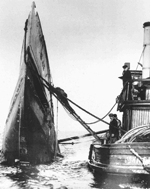 |
379k | S-48 (SS-159) bow up with her crew, contractor's personnel, and naval observers in the tug which took them to New York after their escape. The crew broke in the inner and outer door interlocks to escape from the sunken submarine. | Partial text courtesy of Ric Hedman. USN photo courtesy of Scott Koen & ussnewyork.com. |
|
 |
298k | S-48 (SS-159) pulled to the surface by the salvage cranes. The sub was towed back to Bridgeport, Conn. and the Lake Torpedo Boat Company where she was built. | Text courtesy of Ric Hedman. USN photo courtesy of Scott Koen & ussnewyork.com. |
|
 |
55k | S-48 (SS-159) being salvaged on 20 December 1921. | Text courtesy of Ric Hedman. USN photo courtesy of Scott Koen & ussnewyork.com. |
|
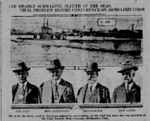 0815931 |
NR | THE DEADLY SUBMARINE, SLEUTH OF THE SEAS The S-48 (SS-159) the latest word in American submarine construction, on her trial trip after she was launched at Lake Torpedo Boat Co., Bridgeport, CT. |
Image and text provided by Oklahoma Historical Society. Photo from The Guthrie Daily Leader. [volume] (Guthrie, Okla.) 1893-1996, 13 February 1922, HOME, Image 7, via chroniclingamerica.loc.gov. |
|
 0815935 |
918k | S-48 (SS-159) with a sea-nice view, circa 1921-22. | Photo courtesy of loc.gov. Reproduction Number LC-DIG-npcc-30138. | |
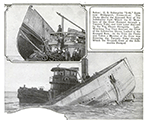 |
511k | Popular Mechanics Magazine photo of the S-48 after she sunk. | Popular Mechanics, February 1922, courtesy of Robert Hurst. | |
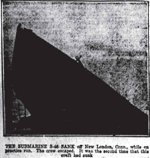 |
640k | THE SUBMARINE S-48 (SS-159) SANK off New London, Conn. while on practice run. The crew escaped. It was the second time that this craft has sunk. | Image and text provided by Penn State University Libraries; University Park, PA. Photo courtesy of Evening Public Ledger. (Philadelphia [Pa.]) 1914-1942, 7 July 1922, Image 26, via chroniclingamerica.loc.gov. | |
 |
97k | S-48 (SS-159) as shown in 1922. Like the last series of E.B. S-boats, the last C&R boats, S-48-51, were long enough to provide gun access hatches (arrowed); note also the sloping tube of the ammunition scuttle crossing behind the hatch). From aft to forward the arrowed tubes in the conning tower fairwater are the tube for the radio ratlines, the retractable mast, the main air exhaust, & the main induction (between the periscopes). The batteries are shaded. |
Drawing & Text courtesy of U.S. Submarines Through 1945, An Illustrated Design History by Norman Friedman. Naval Institute Press. | |
 |
49k | S-48 (SS-159), in 1922, with "clearing lines" running fore and aft. These heavy wires, extending most of the way toward bow and stern, were intended to act as bumpers and protect the conning tower from serious damage if the submarine should surface too close to another ship-something that happened from time to time in those early days of submarining. The first ship of her class, S-48/51; S-48 and her sisters were the largest of the S-boats. | US National Archives photo # 19-N-8274, a US Navy Bureau of Ships photo now in the collections of the US National Archives, submitted by Joseph M. Radigan (of blessed memory) | |
 |
181k | S-48 (SS-159) most likely in mid-January 1924, when she departed Portsmouth for New London, whence she continued south, to the Caribbean, for winter maneuvers. | Text courtesy of DANFS. USN photo from "A Pictorial History of the Naval Oceanographic Office 1830 to 1980", submitted by Joseph M. Radigan (of blessed memory) |
|
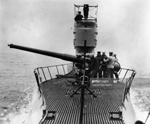 0815913a |
925k | Gun drill on the United States submarine S-48 (SS-159), while traveling at a high rate of speed. This bit of action took place off New London, Conn., just before the submarine joined the fleet. | Image and text provided by Library of Congress, Washington, DC. Photo from Evening Star.(Washington, D.C.) 1854-1972, 04 January 1925, Image 86, via chroniclingamerica.loc.gov. Photo via Getty Images courtesy of gettyimages.com. |
|
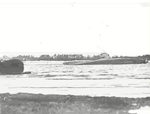 |
39k | On the night of the 29th January 1925, S-48 (SS-159) arrived off the New Hampshire coast. At about 1830, the wind picked up and a heavy snowstorm developed. Visibility was reduced to zero. Soon after 1934, the S-boat grounded on rocks off Jeffrey Point; pulled herself off; then grounded again in Little Harbor. Messages requesting assistance were dispatched. By midnight, the storm had worsened, seas were coming "clean [sic] over the S-48" and she was rolling--15 degrees to port, 60 degrees to starboard. Violent rolling lasted for only a little over thirty minutes but a heavy list developed. By 0330 on the 30th, the battery compartment was taking in water. Chlorine gas was forming. The storm continued; but help arrived at 0500, and Coastguardsmen manning lifeboats rescued the crew. After receiving treatment for exposure and gas at Ft. Stark, crew members were transferred to the Navy Base at Kittery. | Text courtesy of DANFS. USN photo courtesy of Scott Koen & ussnewyork.com. |
|
 0815933 |
NR | Forty-six Officers and Men Trapped in Submarine Off the rocky coast of Portsmouth, N. H., the submarine S-48 (SS-159) is shown listing in icy waters of Atlantic, her crew of 46 saved after a night of horror in chlorine-filled compartment. Storm tossed the craft about like chip on a choppy aea. | Image and text provided by Connecticut State Library, Hartford, CT. Photo from the New Britain Herald. [volume] (New Britain, Conn.) 1890-1976, 2 February 1925, Image 12, via chroniclingamerica.loc.gov. | |
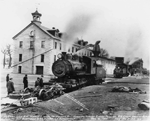 |
583k | On 1 February 1925, salvage operations were begun. A week later, the S-48 (SS-159) was freed and towed to the navy yard for repairs. However, funds were lacking; and, on 7 July 1925, S-48 was decommissioned. On 25 June 1926, repairs and alterations were authorized, and, on 3 February 1927, the work began. But, again, a shortage of funds stopped the project. Caption of photo reads: Navy Yard Portsmouth, N.H. View N.E. down McDonough Ave. showing steam (?) engine pull to R. R.Curve front of Bldg. hauling out of submarine S-48 for major alterations 3 February 1927. |
Text courtesy of DANFS. USN photo # S-48-33 courtesy of Scott Koen & ussnewyork.com. | |
 |
129k | Held fast by lines across her bow as tugs near her stern, the S-48 (SS-159) sits quietly in midstream as a tug nudges her gently. No signal flags are flying and the outer doors of her torpedo tubes are open. There is a small wooden platform attached to her bow just below her name and there appears to be some sort of structural support attached to her hull amidships right at the water line. Therefore, I believe that this photo was taken either shortly after her salvage post sinking, or after her salvage post grounding. Her grounding incident left her stranded on her starboard side and she sustained damage to the pressure hull which resulted in flooding of the battery compartment. The structure seen in the photo attached to the hull is probably some sort of cofferdam used to seal the hull so that she could be pumped out for the tow back to Portsmouth. I believe this photo was taken as she was being pulled into dock at Portsmouth, February, 1925. It might also be her second launch post sea trial sinking. There is no evidence of that cradle shown in her 1925 grounding photos in the dry dock pictures on PigBoats.COM TM A Historic Look at Submarines. Of course it could be the pre modification rebuild when they hauled back out and added 75 feet to the forward battery and buoyancy tank and gunnels. They wouldn't have rebuilt her like that with other subs using the dry dock at the same time. I think she was pulled back up onto the ways for that. Dry docks were valuable for that sort of thing and Lake wasn't building other boats by that time. The ways would have been empty. Even though none of her other grounding photos show the patch/cofferdam she was sitting pretty low in the water and it may not have been visible at that time. Once she was in drydock the patch/cofferdam would have been the first thing that was removed and may not have been in any of the photos. The confirmed launch day photos do not show a launch cradle of this configuration and in most cases the cradle was not rigidly attached to the hull and dropped off and floated away once the boat was waterborne. The post sinking repairs were done at Lake's yard and I dont believe he had a drydock. There was no structural damage in this case that would have required the boat to be hauled back up on the ways, so I would assume that the repair work was all done alongside the pier once they got all the water pumped out. If so, there would have been no need to attach a support cradle for a hauling out and there would have been no re-launching. The other thing that leads me to believe that this is a post-grounding, pre-drydock, Portsmouth photo is the background. It looks more like the area around Portsmouth than it does the area around Lake's Bridgeport yard, when you look at other photos. |
Text i.d. courtesy of David Johnston & Ric Hedman. USN photo courtesy of Scott Koen & ussnewyork.com. |
|
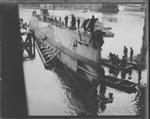 |
907k | Submarine S-48 (SS-159) pulled into shed by locomotives at Portsmouth Navy Yard. | Photo courtesy of the Boston Public Library, Leslie Jones Collection via Sean Hert & flickr.com. | |
 |
471k | Caption of photo reads: Navy Yard Portsmouth, N.H. View west showing locomotives at start of haul from 90 degree block at 11:32 AM hauling out of submarine S-48 for major alterations. | USN photo # S-48-34 courtesy of Scott Koen & ussnewyork.com. | |
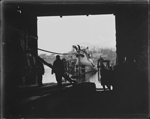 |
613k | Locomotive pulling S-48 (SS-159) into shed at Portsmouth Navy Yard. | Photos courtesy of the Boston Public Library, Leslie Jones Collection via Sean Hert & flickr.com. | |
 |
160k | S-48 (SS-159) was completely rebuilt & rearranged. (A) shows the alterations planned in 1926, including a new sharply raked bow. Note that her battery has been rearranged, divided fore & aft. A new superstructure deck was planned to cover, for example, new boat stowage aft (the boat is shown). Small circles fill the 4-in magazine forward. The radio room (shown insulated) was abaft the control room, with crew quarters abaft it, as well as forward of the officer's quarters forward of the control room. (B) shows her as reconditioned,with a less sharply raked bow. Reconstruction included redistribution of the battery (shaded for clarity), fore & aft of the control room, as in later submarines. Permanent buoyancy tanks were installed fore & aft (indicated by arrows) above the crew's quarters & just abaft of the control room. The pump room was placed under the head just abaft the control room. Note that there was no separate maneuvering room aft, just a motor/engine room forward of the after torpedo room. |
Drawing & Text courtesy of U.S. Submarines Through 1945, An Illustrated Design History by Norman Friedman. Naval Institute Press. | |
 |
119k | In 1928, repair and modernization was carried out on the S-48 (SS-159). In hopes of improving habitability and increasing her range, her hull was extended 25'6"; her displacement was increased to 1,165 tons, and her engines were replaced by German M.A.N. types." This is when the graceful looking hull was added to the original construction. This included bulwarks as can be seen in this 1929 picture taken in New York Harbor while on her transit south for the winter. | Photo courtesy of Ric Hedman. | |
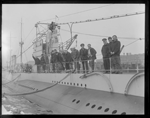 |
748k | S-48 (SS-159) remodeled and ready for trial run off Provincetown, 13 January 1929. | Photos courtesy of the Boston Public Library, Leslie Jones Collection via Sean Hert & flickr.com. | |
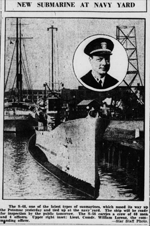 0815930 |
NR | NEW SUBMARINE AT NAVY YARD The S-48 (SS-159), one of the latest types of submarines, which nosed its way up the Potomac yesterday and tied up at the navy yard. The ship will be ready for inspection by the public tomorrow. The S-48 carries a crew of 40 men and 4 officers. Upper right inset: Lieut. Comdr. William Lorenz, the commanding officer. | Image and text provided by Library of Congress, Washington, DC. Photo from Evening Star. [volume] (Washington, D.C.) 1854-1972, 12 February 1929, Image 13, via chroniclingamerica.loc.gov. |
|
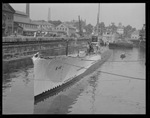 |
959k | S-48 (SS-159) going into drydock at Navy Yard, 29 May 1929. | Photos courtesy of the Boston Public Library, Leslie Jones Collection via Sean Hert & flickr.com. | |
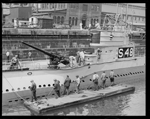 |
405k | S-48 (SS-159) going into drydock at Navy Yard on 29 May 1929. | Photos courtesy of the Boston Public Library, Leslie Jones Collection via Sean Hert & flickr.com. | |
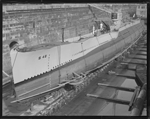 |
910k | S-48 (SS-159) in drydock at Navy Yard, 30 May 1929. | Photos courtesy of the Boston Public Library, Leslie Jones Collection via Sean Hert & flickr.com. | |
 |
92k | Crew photo while assigned to Sub. Div 5. On 1 June 1929, S-48 (SS-159) had been reassigned to SubDiv 4, with which she operated through the end of 1929. Then assigned to SubDiv 3, later SubDiv 5, and then Squadron 3, she continued her operations off the New England coast, with an interruption for winter maneuvers to the south. |
USN photo courtesy of Scott Koen & ussnewyork.com. | |
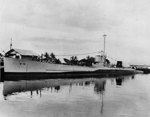 |
162k | S-48 (SS-159), at Submarine Base, Coco Solo, Panama, 16 May 1931. Note her raised bow, with low bulwarks running aft to beyond her 4"/50 deck gun. |
Official USN photo # 80-G-466552, now in the collections of the National Archives. | |
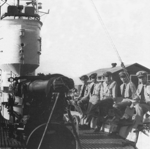 |
702k | A photo of S-48 (SS-159) which was taken in November 1931 at Submarine Base Coco Solo, Panama Canal Zone aboard the boat. Persons from left to right are: LTJG Howard Walter Gilmore as a LCDR, he later commanded the S-48 in 1940 and in 1941 commanded the Shark (SS-174), in 1942 he became 1st CO of the Growler(SS-215) where he was KIA. Howard W. Gilmore (AS-16) was named in honor of him. LT Hyman George Rickover was last CO of the S-9 (SS-114) until 15-APR-1931 and also later commanded the S-48 as a LCDR in 1937. He became Admiral and father of the nuclear navy. Hyman G. Rickover (SSN-709) was named in honor of him. LTJG William Ramon Headden later commanded Plunger (SS-179) from 26-JAN-1939 to 22-FEB-1941 as a LCDR and destroyer Edison (DD-439) from 01-MAR-1942 to 24-02-1943 as a CDR. LTJG Frederic August Graf commissioned the transport ship John Land (AP-167) as CAPT and first CO. LT Olton Rader Bennehoff was CO of S-48 when the picture was taken. He took command of S-48 23-JUNE-1931. He previously commnded Eagle #7 (PE-7) since 24-NOV-1918 and the submarine S-11 (SS-116) since 02-JAN-1926. He probably had a second tour as CO as a LCDR in S-48 in 1934. In WW II he became the one and only CO of amphibious transport ship Thomas Stone (APA-29) from 18-MAY-1942 to 01-APR-1944. |
Text & photo courtesy of Wolfgang Hechler. | |
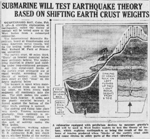 0815934 |
NR | SUBMARINE WILL TEST EARTHQUAKE THEORY BASED ON SHIFTING EARTH CRUST WEIGHTS A submarine equipped with pendulum devices to measure gravity's pull will be used in West Indies waters to test the theory of isotasy, which explains earthquakes as being the result of the release of tension produced when "blocks of the earth’s crust shift and cause strains in other parts of the crust (drawing). ....The expedition, working ashore in the Bahamas and at sea in the U. S. submarine S-48 (SS-159), will check up on whether blocks of the earth's crust are shifting by measuring the pull of gravity at many different points. Gravity is strongest over heavy rock masses. |
Image and text provided by University of Nevada Las Vegas University Libraries. Photo from Las Vegas Age. [volume] (Las Vegas, Nev.) 1905-1947, 03 February 1932, Image 6, via chroniclingamerica.loc.gov. |
|
 |
37k | S-48 (SS-159) was transferred to the Panama Canal Zone Submarine Base, at Coco Solo in On 1 March 1931 whence she operated for four years. She is pictured here in July 1933, she was assigned to the Rotating Reserve. | Partial text courtesy of DANFS. USN photo courtesy of Scott Koen & ussnewyork.com. |
|
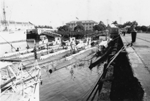 |
765k | Meet the STERN family: S-12 (SS-117), S-11 (SS-116), S-13 (SS-118), S-10 (SS-115) and S-48 (SS-159) pose for a back of the front shot, sometime circa before 20 March 1935, when the S-48 left.
The location is Coco Solo, Panama. One other clue as to the date of the photo is the fact that all the boats are still painted haze gray. There was a date in the mid 30's when the Navy shifted over to basic black for all the boats. I am thinking that this photo was taken just before that date. The boats on the left have all been modified with the safety updates, i.e marker buoys and hatches capable of taking a McCann Rescue Chamber, but they are still all gray. |
Photo courtesy of Kevin Welch. Photo i.d. & text courtesy of Ric Hedman & David Johnston. |
|
 0811807 | 4.18k | Similiar time frame as the above photo: 5 S-boats at Coco Solo. Inboard is S-13 (SS-118), 2 unknown S-boats & S-48 (SS-159) next to the partial outboard unknown S-boat. | Photo courtesy of Walter Fish via Steve Hatchett. | |
 |
15k | Commemorative postal cover marking S-48's (SS-159) decommissioning, 16 September 1935. | Courtesy of Jack Treutle (of blessed memory). | |
 |
67k | These O type and S type submarines which were used during the World War have since been decommissioned and are now laid up in the Phila. Navy Yard. The peaceful surroundings are quite a contrast to those of their active war days. They are pictured here on 17 July 1936. The S-10 (SS-115) was decommissioned on the day this photo was taken at Philadelphia Navy Yard, Philadelphia, PA. and laid up in the Reserve Fleet. Pictured also are any of the following boats that were at the PNY during this time. The O boats:O-1 (SS-62), O-2 (SS-63), O-3 (SS-64), O-6 (SS-67), O-7 (SS-68), O-8 (SS-69), O-9 (SS-70), O-10 (SS-71). The S boats: S-6 (SS-111), S-7 (SS-112), S-8 (SS-113), S-9 (SS-114), S-11 (SS-116), S-12 (SS-117), S-13 (SS-118), S-14 (SS-119), S-15 (SS-120), S-16 (SS-121), S-17 (SS-122) & S-48 (SS-159). |
Photo & text courtesy of A.P. Wire courtesy of philly.com. | |
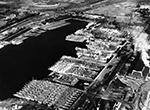 |
2.49k | Philadelphia Navy Yard, 28 October 1940. The photo presented panorama military shipyards in Philadelphia Navy Yard. Most of the ships are obsolete US destroyers, that were transfer to Great Britain under lend lease. The submarines are on the left hand side of the photo, and they are: (in no particular order) The O boats:O-1 (SS-62), O-2 (SS-63), O-3 (SS-64), O-6 (SS-67), O-7 (SS-68), O-8 (SS-69), O-9 (SS-70), O-10 (SS-71). The R boats: R-1 (SS-78), R-2 (SS-79), R-3 (SS-80), R-5 (SS-82), R-6 (SS-83), R-7 (SS-84), R-8 (SS-85), R-9 (SS-86), R-10 (SS-87), R-12 (SS-89), R-15 (SS-92), R-16 (SS-93), R-17 (SS-94), R-18 (SS-95), R-19 (SS-96) & R-20 (SS-97). The S boats: S-11 (SS-116), S-12 (SS-117), S-13 (SS-118), S-14 (SS-119), S-15 (SS-120), S-16 (SS-121), S-17 (SS-122) & S-48 (SS-159). The Olympia (C-6) is shown at the right of the wharf on Broad Street. The stadium in the upper left, was John F. Kennedy Stadium (formally Philadelphia Municipal Stadium)that stood from 1926 to 1992. It was erected for the 1926 Sesquicentennial. |
Photo i.d. courtesy of Ron Reeves (of blessed memory). Photo courtesy of flickr.com. Lower resolution photo. (548k) |
|
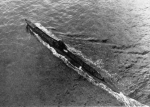 |
89k | S-48 (SS-159), 14 April 1942, off the New England coast. She provided services to submarine and antisubmarine warfare training commands at New London and Portland Maine, until after the end of European hostilities. | USN photo courtesy of Mike Green. Text courtesy of DANFS. |
|
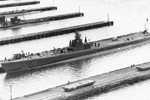 | 294k |
1. R-15 (SS-92) is present. 2. S-14 (SS-119) is present. 3. There is a third Government design S-boat at the top of the photo, one that has a stern torpedo tube. The boat is riding a little high, and the tube can just be seen, right at the waterline. 4. The fleet boat is a EB design Mod 3 Gato. Here is what can be reasonably inferred from the facts: 1. The photo was taken during WWII. 2. The photo was probably taken in New London. R-15 and S-14 operated exclusively in the Atlantic during the war, as did all of the Government design S-boats. 3. Assuming New London for a location, R-15 and S-14 were both there starting in April 1944. 4. Using April 1944 for a rough date, that narrows the choices of fleet boats considerably. It would have to be a late construction EB Gato. Only Cavalla (SS-244), Cobia (SS-245), and Croaker (SS-246), all built at the Victory Yard downstream would have been present in April 44. Croaker was actually the last Gato built by EB. All the other EB ways were already cranking out Balaos at this time. In fact, the first three EB Balaos had already been commissioned by this date. 5.S-48 (SS-159) was one of the eight Government design S-boats with a stern torpedo tube. Of the eight, only S-11 (SS-116) to 13 (SS-118), and S-48 were still in existence, the others had all been scrapped prior to the war. S-11, 12, and 13 operated exclusively in the Caribbean at this time. So, to sum up: the photo was taken approximately April 1944 in New London, the fleet boat could be Cavalla, Cobia, or Croaker (and I would lean heavily to Croaker), and the S-boat at the top is probably S-48. | Photo i.d. courtesy of David Johnston, Ric Hedman, John Hummel & Robert Morgan. Text courtesy of David Johnston USN photo courtesy of Scott Koen & ussnewyork.com. |
|
| Back To The Main Photo Index | Back To the Submarine Index |
|
Problems and site related matters, E-mail Webmaster |
|
This page is created and maintained by Michael Mohl All Pages © 1996 - 2024 NavSource History |